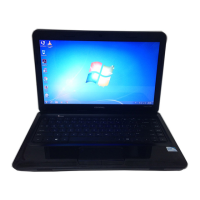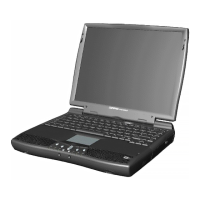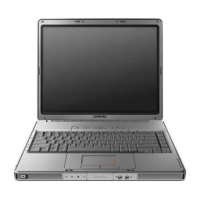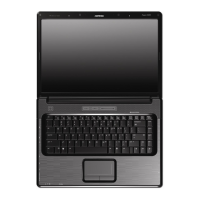Do you have a question about the Compaq Presario A900 and is the answer not in the manual?
Details various Intel Core and Celeron processors used in the notebook.
Information on Intel GM965 and GL960 chipsets.
Describes Unified Memory Architecture (UMA) graphics subsystem.
Specifications for the 17.0-inch WXGA+BrightView display panel.
Details memory module slots, dual-channel support, and RAM configurations.
Information on supported hard drive sizes and accessibility.
Specifies optical drive types and accessibility.
Notes support for external USB diskette drives only.
Describes the integrated VGA camera specifications.
Details the integrated omnidirectional microphone.
Information on high-definition audio and speakers.
Specifications for the 56K V.92 data/fax modem.
Details the 10/100 network interface card.
Covers integrated WLAN options and supported formats.
Lists supported digital card formats for the media slot.
Describes various input/output ports like USB, audio, video, and network.
States that docking support is none.
Details keyboard features and TouchPad functionality.
Information on AC adapter and battery specifications.
Mentions the security cable slot.
Lists preinstalled Windows Vista versions.
Lists end-user replaceable parts.
Identifies internal display switch, wireless antennae, webcam, and microphone.
Identifies speakers, wireless button, and various indicator lights.
Explains functions of Fn key, Esc key, function keys, and Windows keys.
Details TouchPad, its buttons, scroll zones, and light status.
Identifies audio-out and audio-in jacks.
Identifies USB ports, optical drive, and security cable slot.
Identifies power connector, vents, modem, network, monitor, S-Video, and media slot.
Identifies battery bay, release latch, vents, and module compartments.
Shows location of serial number on the bottom of the computer.
Provides an exploded view of the notebook's main components.
Lists spare parts for the display assembly, including bezel and panel.
Details parts included in the plastics kit, like covers.
Lists spare parts for optical drives and hard drives.
Lists spare parts like AC adapters and power cords.
An index of spare part numbers and their descriptions.
Lists necessary tools and general service considerations for repairs.
Guidelines for handling and routing cables during service.
Precautions for safely handling hard drives and optical drives.
Explains electrostatic discharge (ESD) and prevention methods.
Procedures for safely packaging and transporting ESD-sensitive equipment.
Recommendations for setting up a safe and effective repair workstation.
Recommendations for grounding equipment during service.
Steps to clear CMOS and user passwords by removing the RTC battery.
Explains where to find the serial number for service requests.
Details the location and part number for computer feet.
Procedure for removing and installing the notebook battery.
Step-by-step guide to remove and install the integrated camera module.
Instructions for removing and installing the computer's hard drive.
Procedure for removing and installing memory modules (RAM).
Steps to remove and install the wireless LAN module.
Instructions for removing and installing the optical drive.
Procedure for removing and replacing the switch cover and keyboard assembly.
Detailed steps for removing and installing the entire display assembly.
Instructions for removing and replacing the top cover of the notebook.
Procedure for removing and installing the USB interface board.
Steps to remove and install the computer's cooling fan.
Procedure for removing and installing the speaker assembly.
Detailed instructions for removing and installing the main system board.
Steps for removing and installing the power connector cable.
Procedure for removing and installing the Real-Time Clock (RTC) battery.
Instructions for removing and installing the digital media board.
Steps for removing and installing the heat sink assembly.
Detailed procedure for removing and installing the CPU.
How to access and launch the system's BIOS setup utility.
Guide to changing the language displayed in the Setup Utility.
Explains keyboard controls for navigating and making selections within the utility.
How to view computer hardware and system information in the utility.
Procedure to load factory default settings for system configuration.
Overview of advanced options like drive self-test and boot order.
Methods to exit the Setup Utility, with or without saving changes.
Overview of the different menus and options available in the utility.
Lists overall physical dimensions, weight, power, temperature, and environmental specs.
Technical details for the notebook's display panel.
Performance and physical details for supported hard drives.
Technical specifications for the optical drive's read/write capabilities.
Technical details for the standard combo optical drive.
Lists Direct Memory Access (DMA) channel assignments.
Details hardware interrupt (IRQ) assignments for system components.
Lists I/O port addresses used by system functions.
Outlines memory address ranges and their system functions.
Details of black Phillips PM2.5x6.0 screws and their usage locations.
Details of silver Phillips PM3.0x4.0 screws and where they are used.
Details of black Phillips PM2.0x4.0 screws and their applications.
Details of black Phillips PM2.5x9.0 screws and their locations.
Details of black Phillips PM2.5x5.0 screws and their usage.
Details of silver Phillips PM2.5x7.0 screws and their placement.
Overview of tools for safeguarding and restoring system data.
Steps to create recovery discs for system restoration.
Guidance on when and how to back up important system files.
How to create and use system restore points to revert changes.
Step-by-step guide to creating a system restore point.
Instructions for reverting the system to a prior restore point.
Explains system recovery options using Recovery Manager or partition.
Procedure to restore the system using created recovery discs.
Steps to perform system recovery from the internal recovery partition.
Pinout details for the audio output jack.
Pinout details for the audio input jack.
Pinout information for connecting an external monitor.
Pinout details for the RJ-11 modem connector.
Pinout details for the RJ-45 network connector.
Pinout details for the S-Video output connector.
Pinout details for the USB port.
General specifications for power cords applicable globally.
Country-specific requirements and certifications for power cords.
Guidance on proper disposal of used computer batteries.
Information on recycling display components, including mercury warnings.
| Graphics | Intel Graphics Media Accelerator X3100 |
|---|---|
| Operating System | Windows Vista Home Premium |
| Battery | 6-cell Lithium-Ion |
| Processor | Intel Pentium Dual-Core T2370 |
| RAM | 1GB DDR2 |
| Storage | 160 GB HDD |
| Display | 17-inch WXGA+ 1440 x 900 |
| Optical Drive | DVD±RW SuperMulti with Double Layer Support |
| Networking | 802.11b/g |
| Ports | 3 x USB 2.0, VGA, LAN, Headphone output, Microphone input |











